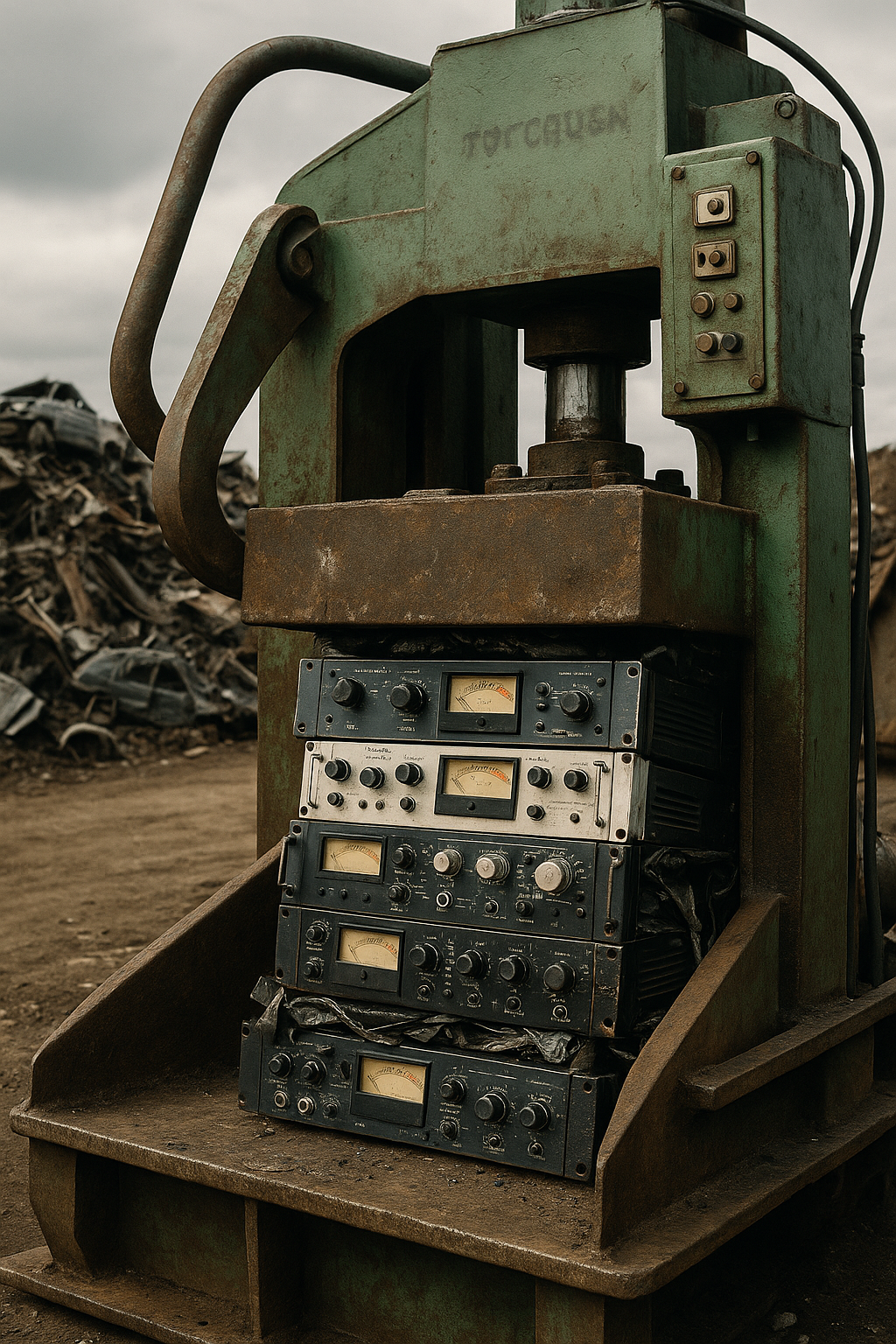Audio Compression: From Leveling Tool to Psychoacoustic Shaper

Introduction:
Why Compress?
Audio compression is one of the most fundamental tools in music production, broadcasting, and film sound.
Its primary function is to reduce the dynamic range—the difference between quiet and loud parts—making audio more consistent,
intelligible, and controlled in a mix.
But compression today is more than level control: It can enhance punch, warmth, presence, depth, and even emotional intensity.
It's a creative tool with roots in physics, signal theory, and psychoacoustics.
Basics:
What Does a Compressor Do?
A compressor detects when an incoming signal exceeds a threshold and reduces those peaks according to the ratio (e.g., 4:1).
Other parameters—attack, release, knee, and make-up gain—control its timing and tonal characteristics.
Typical Use Cases:
- Vocals: Consistent level, intimate feel, intelligibility.
- Drums: Punch, control, transient shaping.
- Mix Bus: Glue effect, cohesion, loudness management.
- Mastering: Subtle gain control, detail preservation.
Audio Compressors – Types, Character & Applications
Audio compressors are fundamental tools in mixing and mastering.
They control dynamic range, but also sculpt tone, add character, and shape the emotional arc of music.
Core Principle:
A compressor reduces a signal’s gain once it passes a certain threshold. Key parameters include:
- Ratio: Degree of compression
- Attack: How quickly compression starts
- Release: How quickly it resets
- Knee: The curve between uncompressed and compressed behavior
Analog Compressor Types:
-
VCA (Voltage Controlled Amplifier)
- Fast, clean, precise
- Famous models: SSL G Bus, dbx 160
- Best for: Drums, mixbus, vocals
- Sound: Punchy, tight, controlled
-
FET (Field Effect Transistor)
- Very fast and colorful compression
- Famous model: Urei 1176
- Best for: Vocals, bass, snare
- Sound: Aggressive, lively, full of character
-
Opto (Optical Compressor)
- Uses a light cell for compression – slow, musical
- Famous model: Teletronix LA-2A
- Best for: Vocals, guitars, mastering
- Sound: Smooth, warm, organic
-
Vari-Mu (Variable Gain Tube Compressor)
- Tube-based with program-dependent behavior
- Famous model: Fairchild 670, Manley Vari-Mu
- Best for: Mastering, buses, vocals
- Sound: Silky, round, luxurious
Digital Compressors & Plugins
-
Emulations of Analog Classics
- Plugins replicating VCA, FET, Opto, Vari-Mu
- Brands: UAD, Waves, Plugin Alliance
- Pros: Affordable, recallable, noiseless
-
Multiband Compressors
- Split signal into frequency bands
- Control dynamics independently per band
- Best for: Mastering, full mixes, complex signals
-
Sidechain Compressors
- Triggered by an external input
- Classic EDM use: Kick → Ducking bassline
-
Lookahead Compressors
- Predict peaks using latency
- Useful for precise limiting, broadcast
-
AI & Intelligent Compressors
- Tools like iZotope Neutron, smart:comp
- Use machine learning for optimal settings
- Efficient and fast, but not always musical
Each type of compressor has a unique fingerprint and ideal use case.
Understanding how, why, and where to use them separates the technician from the artist.
Whether analog or digital — what matters is the result in the mix and the intended emotional impact.
Scientific Depth
Compression is based on nonlinear signal processing. It affects transient response, harmonic structure, and even perceived loudness.
Psychoacoustic Relevance:
Our ears are non-linear sensors. We don’t hear all frequencies equally, and we miss quiet elements in the presence of louder ones.
Compression reshapes the signal to fit the ear’s psychology—helping subtle elements emerge and emphasizing rhythm through dynamic movement or “pumping.”
Creative Applications
Advanced techniques include:
- Parallel Compression (“New York compression”)
- Sidechain Compression (e.g., kick triggers bass ducking)
- Multiband Compression (frequency-selective control)
- Envelope Shaping / Transient Designing
- Upward Compression: Lifts quiet parts instead of taming peaks
Conclusion
Compression isn’t just about making things louder or more controlled—it’s about expression.
When used with intention, compression becomes an artistic, even emotional decision.
Great mixes breathe because the engineer knows when to compress, why, and how much.
In the end, compression is as much about listening as it is about measuring.
Audio Compression – Deep Dive & Hardware vs Plugin
1. The Sonic Depth of Compression
Compression doesn't just control levels — it shapes how we perceive sound. Let's go deeper:
-
Transient Shaping
Compressors manipulate the attack and decay of sounds. This significantly affects perceived texture and definition.
Punch is not just volume — it’s how the compressor treats micro-attacks. -
Harmonics & Nonlinear Behavior
Analog compressors generate subtle harmonic distortion due to their circuitry (VCA, FET, tube, opto, etc.).
These overtones can be musical and pleasing — plugins replicate them via algorithms,
but real components interact with electricity in ways DSP can only approximate. -
Envelope Behavior
The dynamic interplay between attack and release alters rhythm, density, and vibe.
Digital compressors offer lookahead functions for ultra-clean control — impossible in analog but powerful in surgical settings. -
Micro- vs. Macro-Dynamics
Great compression addresses both:- Macro (verse vs. chorus dynamics)
- Micro (detail articulation within a single note or phrase)
Bad compression flattens a mix. Great compression enhances energy and emotion.
2. Compression & Psychoacoustics
Compression interacts with how we hear and feel audio:
- Masking: Loud elements hide quiet ones. Compression lifts details into audibility.
- Perceived Loudness: Compressed tracks feel louder even with identical peaks.
- Emotional Flow: Dynamics create impact, space, intimacy. Over-compression = fatigue.
3. Hardware vs Plugins – What Really Changes?
Hardware Compressors
- Built with physical components (transformers, tubes, opto-cells)
- Every unit sounds slightly different
- Naturally nonlinear, colored, complex
- Often described as more dimensional, “alive”, or "organic"
- Drawbacks: expensive, bulky, no instant recall
Plugins
- Use digital modeling or emulation (DSP)
- Great for precise, repeatable, total control
- Clean or colored — depends on algorithm quality
- Pros: affordable, fast, consistent
- Cons: often less 3D, less “feel” under heavy processing
Hybrid Systems
Many engineers mix both: Plugins for control, Hardware for vibe.
Understanding what each offers allows you to make sound that breathes and connects.
Conclusion
Compression is part science, part art, part psychoacoustics.
The real difference between hardware and plugins lies in how they interact with energy, signal, and soul.
Mastering both gives you complete control — from clinical precision to analog magic.
FAQ – Audio Compression
Q: What is the main purpose of audio compression?
A: To reduce dynamic range, making audio more consistent, controlled, and intelligible.
Q: What are the main types of analog compressors?
A: VCA, FET, Opto, and Vari-Mu – each with unique sonic characteristics.
Q: Why use digital compressors or plugins?
A: They offer precision, recallability, affordability, and advanced functions like multiband or lookahead.
Q: How does compression affect psychoacoustics?
A: It reshapes sound to match how our ears perceive loudness, detail, and rhythm, enhancing emotional impact.
Q: Hardware vs Plugins – which is better?
A: Hardware offers organic, nonlinear depth, while plugins provide consistency and precision. Many engineers combine both.
About the Co-Author
CB MASTERING – partner in crime at NexaTunes Blog
📧 cbmastering@gmx.de · 🔗 linktr.ee/cb.mastering
